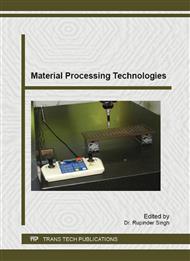[1]
Kilickap, E., Huseyinoglu, M., Yardimeden, A., Optimization of drilling parameters on surface roughness in drilling of AISI 1045 using response surface methodology and genetic algorithm, Int. J. of Adv. Manuf. Technol. Vol. 52 (2010) pp.79-88.
DOI: 10.1007/s00170-010-2710-7
Google Scholar
[2]
Iliescu, D., Gehin, D., Gutierrez, M. E., Girot, F., Modeling and tool wear in drilling of CFRP, Int. J. of Machine Tools and Manufacture Vol. 50 (2010) pp.204-214.
DOI: 10.1016/j.ijmachtools.2009.10.004
Google Scholar
[3]
Durão, L. M. P., Gonçalves, D.J.S., Tavares, J. M. R.S., V., Albuquerque, V. H.C., Vieira, A. A., and Marques, A.T., Drilling tool geometry evaluation for reinforced composites laminates, J. of Composites Structure Vol. 92 (2010) pp.1545-1550.
DOI: 10.1016/j.compstruct.2009.10.035
Google Scholar
[4]
Kilickap, E., and Huseyinoglu, M., Selection of optimum parameters on burr height using response surface methodology and genetic algorithm in drilling of AISI 304 stainless steel, J. of Materials Manuf. Process, Vol. 25 (2010) pp.1068-1076.
DOI: 10.1080/10426911003720854
Google Scholar
[5]
Seeman, M., Ganesan, G., Karthikeyan, R., and Velayudham, A., Study on tool wear and surface roughness in machining of particulate aluminum metal matrix composite response surface methodology approach, Int. J. of Adv. Manuf. Technol., Vol. 48 (2010).
DOI: 10.1007/s00170-009-2297-z
Google Scholar
[6]
Çaydaş, U., Hasçalık, A., Buytoz, O., and Meyveci, A., Performance evaluation of different twist drills in dry drilling of AISI 304 austenitic stainless steel, J. of Material and Manuf. Process Vol. 26 (2011) pp.951-960.
DOI: 10.1080/10426914.2010.520790
Google Scholar
[7]
Tosun, G., Statistical analysis of process parameters in drilling of AL/SICp metal matrix composite, Int. J. of Adv. Manuf. Tech. Vol. 55 (2011) pp.477-485.
DOI: 10.1007/s00170-010-3103-7
Google Scholar
[8]
Krishanraj, V., Prabukarthi, A., Ramanathan, A., Elanghovan, N., Kumar, M.S., Zitoune, R., and Davim, J.P., Optimization of machining parameter at high speed drilling of carbon fiber reinforced plastics (CFRP) laminates, J. of Composites, Vol. 43 (2012).
DOI: 10.1016/j.compositesb.2012.01.007
Google Scholar
[9]
Tansel, I.N., Demetgul, M. Li.M., Bickraj, K., Kaya, B., and Ozcelik, B., Detecting chatter and estimating wear from the torque of end milling signals by using index based reasoned(IBR), Int. J. of Adv. Manuf. Tech. Vol. 58 (2012) pp.109-118.
DOI: 10.1007/s00170-010-2838-5
Google Scholar
[10]
Mukherjee, I., and Ray, P.K., A review of optimization techniques in metal cutting processes, J. of Computers and Ind. Eng. Vol. 50 (2006) pp.15-34.
Google Scholar
[11]
Rajmohan, T., and Palanikumar, K., Experimental investigation and analysis of thrust force in drilling hybrid metal matrix composites by coated carbide drills, J. of Materials Manuf. Process, Vol. 26 (2011) pp.961-968.
DOI: 10.1080/10426914.2010.523915
Google Scholar


